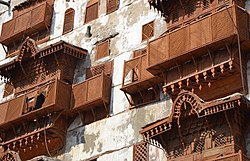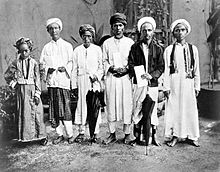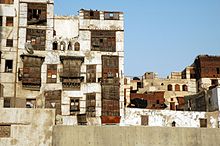Old town of Jeddah, the gate to Mecca
| Old town of Jeddah, the gate to Mecca | |
|---|---|
|
UNESCO world heritage |
|

|
|
|
Wooden window bay on a house in the Al-Balad district (Jeddah) |
|
| National territory: |
|
| Type: | Culture |
| Criteria : | (ii), (iv), (vi) |
| Surface: | 17.92 ha |
| Buffer zone: | 113.58 ha |
| Reference No .: | 1361 |
| UNESCO region : | Arabic states |
| History of enrollment | |
| Enrollment: | 2014 (session 38) |
The old town of Jeddah, the gateway to Mecca , has been a UNESCO World Heritage Site in Saudi Arabia since 2014 .
Historic Jeddah is a port city on the Red Sea . It was the destination of ships that transported goods for Mecca across the Indian Ocean , at the same time it was a transit station for all Mecca pilgrims who traveled by ship. Jeddah became prosperous as a result and developed its own architectural tradition, in which the construction techniques of the coastal towns of the Red Sea were combined with craft techniques that had been developed along the trade routes.
Thanks to the Hajj pilgrimage , the population of Jeddah was multicultural; Muslims from Asia, Africa and the Middle East had settled here.
description
The building material of the old buildings is coral rubble and clay mortar, reinforced by horizontally drawn-in beams. The facades are plastered with clay and often decorated with sgraffito .
In general, Jeddah's infrastructure, which is tailored to the flow of pilgrims, is better preserved than the one that traditionally served the movement of goods. The city map and the road network go back to the 16th century, but there are only a few monuments from this period. The old town is characterized by the construction work that was carried out in the heyday of the 18th century, but especially in the late 19th century.
In the 1970s there were around 1000 monuments in the old town of Jeddah, but as a result of the modernization in 2010, only 350 of them remained (280 in the area designated as a World Heritage Site).
Residential houses
Tower-like houses with large wooden roshan are typical of the architecture of Jeddah . The Roshan are window bay windows that on the one hand served to protect privacy and on the other hand, in connection with the wind towers, for air circulation. Up to seven floors were built because there was little space in the old town. The families of wealthy merchants lived here in the late 19th century. These tower-like houses are surrounded by relatively low residential buildings, mosques, ribats , souks and small squares, which together form a lively urban space.
The generously proportioned city apartments of the rich merchants are now only rarely inhabited by members of the upper class. Usually the houses were subdivided later in order to rent them out to several parties. Most of the old town houses are privately owned and rented to poor immigrants.
Pilgrims' quarters
While the poorer pilgrims once slept where they just found a place, there were private quarters for more affluent Mecca pilgrims, but above all large pilgrimage hostels ( wikala ). When they were nominated as UNESCO World Heritage, these hostels were highlighted as an important urban planning element, but, as ICOMOS critically noted, not a single hostel was located more precisely, so it is uncertain how many of these buildings that were once typical of Jeddah still exist.
Another accommodation option for pilgrims was in a ribat . Most of the eleven ribats that still exist in Jeddah are closed; three are located in the World Heritage area and one of these three buildings is still used in a comparable way, namely as a home for poor widows. Restoration work is planned to preserve this type of building.
Mosques
The Great Mosque was demolished in the 1990s and replaced by a new building. Nine historical mosques are located in the part of the old town designated as World Heritage. Two of them are architecturally significant:
- Masjid asch-Schāfiʿī (built in the 13th century, but its current state largely determined by a renovation (1539) in the Indian Mogul style ).
- Masjid al-Miʿmār.
No information was provided about the other seven mosques at the time of nomination.
World Heritage Criteria

Criterion II
Jeddah's architecture is a testament to the cultural exchange that took place between the 16th and early 20th centuries with people living near the Red Sea and the Indian Ocean. It concerned craft techniques and building materials. For the special requirements of a very hot and dry climate, innovative and aesthetic designs were developed.
Criterion IV
The Roshan tower houses typical of Jeddah can be directly linked to the opening of the Suez Canal (1869). The merchants in Jeddah particularly benefited from this newly opened sea trade route. The rich profits from the trade were the reason for the construction of the representative houses in the late 19th century. The new architectural style was adopted in the cities of Medina , Mecca and Taif , but has completely disappeared there in the course of modernization and has only been preserved in Jeddah.
Criterion VI
Jeddah is closely linked to the pilgrimage to Mecca. For centuries, sheltering pilgrims arriving by ship was an important task. The pilgrims brought goods from their homeland, which were traded in the market in Jeddah.
Integrity and authenticity
The world heritage comprises about a third of the old town enclosed by the city walls. In addition to the Roshan tower houses, various forms of construction are represented, which served as pilgrims' accommodations, department stores, etc. There are examples of traditional facade decoration and special building techniques adapted to the climate. ICOMOS saw the integrity of the world heritage in jeopardy, because Jeddah had already lost much of its historical building fabric as a result of the rapid transformation and modernization process. For example, arson was a method to remove a historic building and use the building site for a lucrative new building.
According to the Saudi Arabian government as the applicant, historic Jeddah is authentic in that it is still a vibrant old town and a thriving commercial center. Many of the old buildings are in good condition and the renovations have not changed the substance of the buildings. However, ICOMOS saw no continuity in today's old town with the earlier functions as a pilgrimage station and trading center. The city is only a shadow of its former size, and many old buildings are inhabited by tenants who do nothing to preserve the building fabric. A successful renovation of the buildings and revitalization of the old town could restore the authenticity in the future.
Protection and management of the world heritage site
A royal decree of November 2014 placed historic Jeddah under protection. The management of the world heritage is the responsibility of the city administration and is supplemented by a welfare system that serves the needs of the population. In the long term, buildings that are vacant or have been occupied by poor immigrants are to be upgraded with the help of a management plan. Real estate speculation should also be controlled more closely.
Web links
- Old town of Jeddah, the gateway to Mecca on the UNESCO World Heritage Center website ( English and French ).
- Advisory Board Evaluation ( ICOMOS ): Historic Jeddah, the Gate to Makkah (Kingdom of Saudi Arabia) No 1361 , March 2014 ( PDF )
Individual evidence
- ↑ a b c ICOMOS: Historic Jeddah, the Gate to Makkah. P. 90 , accessed on November 5, 2018 .
- ↑ a b c ICOMOS: Historic Jeddah, the Gate to Makkah. P. 91 , accessed on November 5, 2018 .
- ^ ICOMOS: Historic Jeddah, the Gate to Makkah. P. 96 , accessed November 5, 2018 .
- ↑ a b c ICOMOS: Historic Jeddah, the Gate to Makkah. P. 94 , accessed on November 5, 2018 .
- ^ ICOMOS: Historic Jeddah, the Gate to Makkah. P. 96 , accessed November 5, 2018 .
Coordinates: 21 ° 29 ' N , 39 ° 11' E

